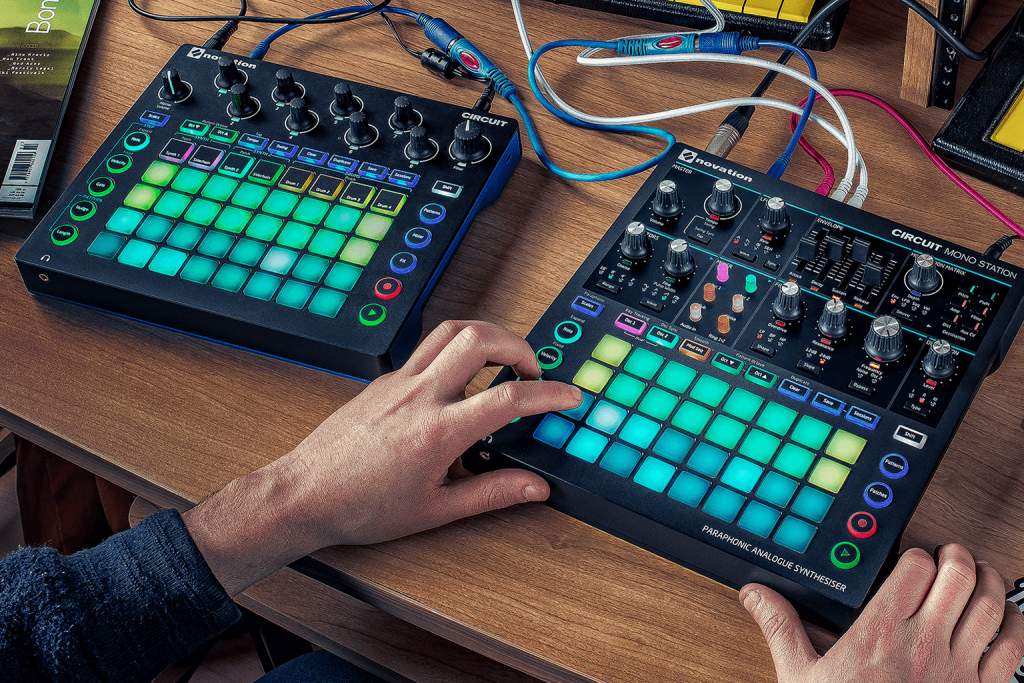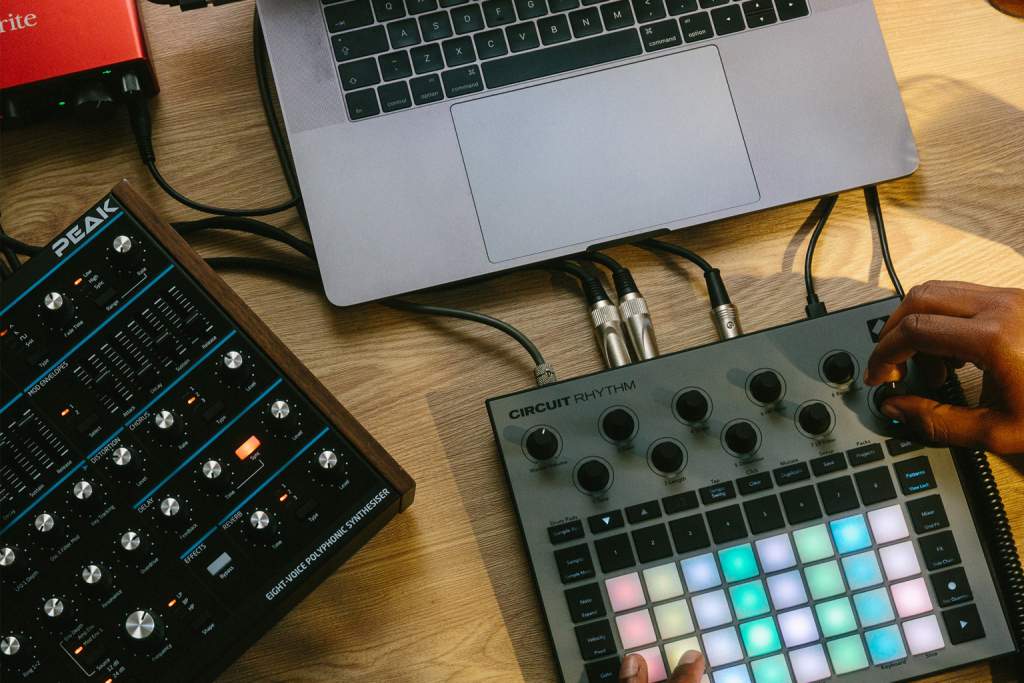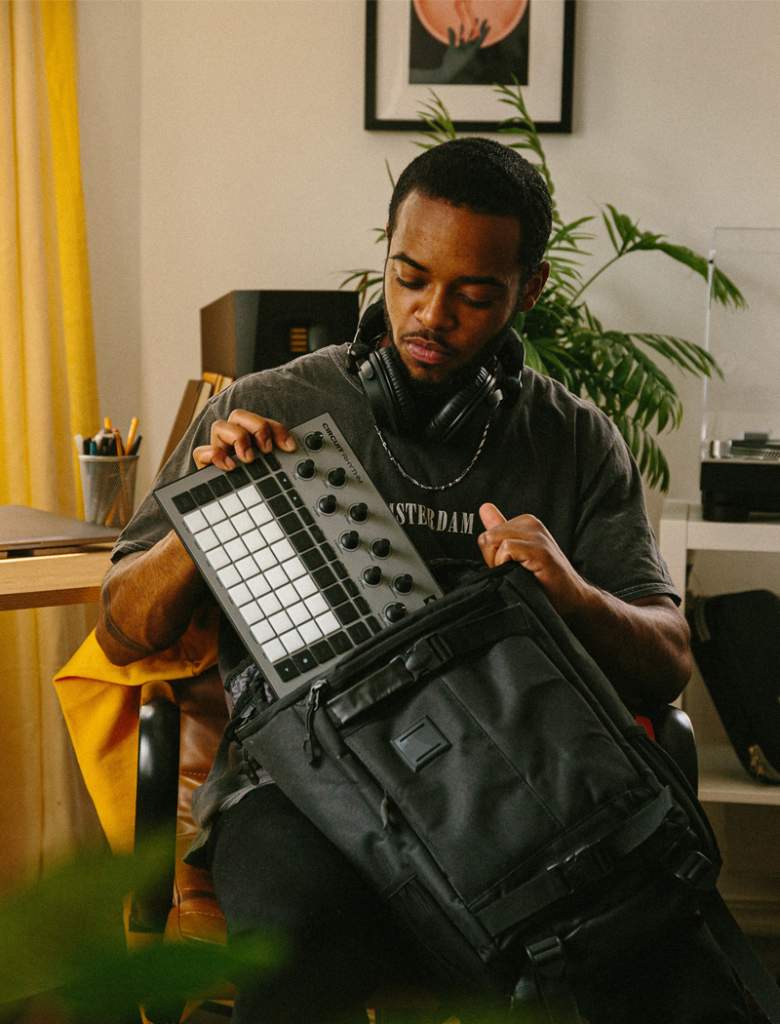When Novation launched the Circuit Tracks at the start of this year, they also announced another new product in the Circuit line. Marketed as a versatile and intuitive sampler, the Circuit Rhythm quickly became one of the most hyped releases of 2021. With both products now shipping to customers, we compared the Circuit Rhythm vs Circuit Tracks to see how they fit into the popular product line.
Novation Circuit Line

The original Circuit groovebox was released in 2015. Featuring a sequencer, synthesizer, and drum machine all-in-one, the Circuit allowed users to quickly and easily construct their own pattern-based musical sequences. Featuring two synth tracks, four drum tracks, a 4×8 sequencing grid, and a simple yet intuitive interface, the compact and affordably priced Circuit was immediately popular with producers, DJs, and musicians of all skill levels.
In 2017, Novation released another groovebox, the Circuit Mono Station. Instead of the polyphonic digital synths found in the Circuit, the Mono Station was equipped with a paraphonic analogue synthesizer. The groovebox also featured some new controls and features for creating monophonic and paraphonic tones. While less popular than the Circuit, the Mono Station was generally well-received, although it has since been discontinued.
More recently, in February 2021, Novation announced the Circuit Tracks and Circuit Rhythm. While the Circuit Tracks was announced as a direct update of the original Circuit, Novation describes the Circuit Rhythm as a “versatile sampler for making and performing beats.” We’ve taken a closer look at both models below to see how they compare.
Circuit Tracks
When comparing the Circuit Tracks to the original Circuit, we called it a “fantastic groovebox.” Maintaining the affordability and usability of its predecessor while offering more advanced capabilities, the Circuit Tracks is a shining example of a perfect upgrade.
Featuring the same synth and drum tracks as the original Circuit, the Tracks also offers two MIDI tracks (with full-size ports). This allows you to sequence and mix external instruments via the groovebox, in addition to the built-in synth and drum tracks. Two mono audio inputs also allow you to feed external signals into the Tracks for mixing or applying sound effects to.
These features make the Tracks the perfect centerpiece of your setup. The groovebox allows you to create 32-step patterns, which can be chained to build sequences with up to 256 steps per track. Multiple patterns and pattern chains can be assigned to a single drum pad, called a scene. Scenes can also then be chained together, ultimately allowing you to create more complex musical arrangements.
Meanwhile, expandable storage enables you to save and access up to 31 packs via MicroSD, in addition to the 1-pack internal memory. Each pack can hold 128 patches and up to 64 projects.
Despite its new features, the Circuit Tracks maintains the intuitive workflow and usability of its predecessor that make it great for live performances. The battery-powered groovebox is also very lightweight and portable, making it easy to take with you wherever you go. Topped off with an affordable $399.99 price tag, it’s easy to see why the Circuit Tracks holds such appeal to beginner, intermediate, and experienced producers.
Circuit Rhythm
The Circuit Rhythm is a sampler, not a groovebox. It’s designed to complement an existing setup, rather than serve as the base like the Circuit Tracks. The most critical distinction between the two models is that the Rhythm allows users to record samples directly into the hardware, before transforming them into their own unique beats. While you can load samples into the Tracks, you cannot record them directly to the unit, and have less effects and tools to experiment with.
The Rhythm features eight sample tracks with 32-step patterns each, chainable for up to 256-steps per track. While sample duration is limited to 3 minutes and 40 seconds, you can record up to 128 samples per pack. For comparison, the Circuit Tracks offers 64 sample slots per pack. Like the Tracks, the Rhythm also offers expandable storage via MicroSD.
The Rhythm features full-size MIDI in, out, and thru ports, as well as analogue sync out, so it can easily connect with an existing setup. The sampler also has a stereo input; however, samples are summed to mono as they’re recorded. While being limited to monophonic tones may be a dealbreaker for some, the Rhythm ultimately offers a remarkable level of control over your samples.

Once recorded, you can use the Rhythm to slice, resample, or play the samples chromatically. You also have a variety of playback modes (One-Shot, Gated, Loop, Reverse, Choke) and Grid FX (Beat Repeat, Vinyl Simulation, Reverse, Gator, Phaser) to help you transform your samples into a groove. There’s also unquantized recording functionality, and a more comprehensive side chain feature than the one found on the Tracks.
If you already own a Circuit Tracks, you’ll take to using the Rhythm very easily. Like the groovebox, the Rhythm has a sleek, screenless interface, with a 4×8 grid of velocity sensitive pads. The workflow is also very similar: intuitive, and geared towards live performance. The small, lightweight, and battery-powered sampler is also just as portable as the Tracks.
The Circuit Rhythm costs $399.99. While it’s not without limitations, there is simply not another sampler at this price point with the Rhythm’s capabilities.
Circuit Rhythm vs Circuit Tracks Spec Comparison
The side-by-side spec comparison below highlights the biggest differences between the Circuit Rhythm vs Circuit Tracks.
| Specification | Circuit Tracks | Circuit Rhythm |
|---|---|---|
| Price | $399.99 | $399.99 |
| Synth Tracks | 2 x 6-voice polyphonic | 0 |
| Sample Tracks | 4 x Drum Tracks | 8x Flexible Sample Tracks |
| MIDI Tracks | 2 x 6-voice polyphonic with custom templates | 0 |
| Click Track | Yes | Yes |
| Audio Inputs | 2x Mono | Stereo L/R pair |
| Records Samples | No | Yes (mono-summed) |
| Send External Inputs to Delay/Reverb/Side Chain | Yes | No |
| Send to Grid FX | No | Yes |
| Sample Playback | One-shot only | Slice, Chromatic, One-Shot, Gated, Looped, Reverse |
| Sample Controls | Tune, Decay, Distortion, EQ | Tune, Start, Length, Slope, Distortion, High-pass Filter, Low-pass Filter, Resonance |
| Sample Choke Group | No | Yes |
| Send FX | Delay, Reverb, Side Chain | Delay, Reverb, Side Chain |
| Master Compressor | Yes | Yes |
| Grid FX | No | Vinyl Simulation, Beat Repeat, Phaser, Gater, Reverse, Auto-Filter, and Digitiser |
| Scale Mode | Yes | No |
| Note Repeat | No | Yes |
| Projects (per pack) | 64 | 64 |
| Sample time per pack (seconds) | 196.6 | 220 |
| Samples per pack | 64 | 128 |
| Synth Presets (per pack) | 128 | N/A |
| Expandable storage | microSD | microSD |
| Pattern length | up to 32 steps (256 when chained) | up to 32 steps (256 when chained) |
| Pattern settings | Sync rate and Pattern Direction | Sync rate and Pattern Direction |
| Step Probability | Yes | Yes |
| Pattern Mutate | Yes | Yes |
| Scenes | 16 per project | 16 per project |
| View Lock | Yes | Yes |
| MIDI I/O & Sync | Full Size MIDI In, Out and Thru Sync Out | Full Size MIDI In, Out and Thru Sync Out |
| Battery | Built-in rechargeable Lithium-ion battery | Built-in rechargeable Lithium-ion battery |
| USB | USB-C | USB-C |
| Dimensions (width x depth x height) | 240mm x 210mm x 30mm (40mm height including knob caps) | 240mm x 210mm x 30mm (40mm height including knob caps) |
| Weight | 1.72 lbs (780g) | 1.72 lbs (780g) |
The Verdict

Ultimately, the Circuit Rhythm and the Circuit Tracks serve different yet complementary purposes. The Circuit Tracks is designed to be the brain of your setup, with external signals flowing in and out of the groovebox as you mix, sequence, and create your music.
Conversely, the Circuit Rhythm allows you to record, slice, and sculpt samples into your own mix, which you can then feed into the Tracks to include in larger, more complex arrangements.
Both units are also highly portable – you can carry them in the same backpack – not to mention remarkably affordable, given their capabilities. All the while offering a similarly versatile and easy-to-use workflow.
Whether you invest in the Tracks, Rhythm, or both, depends on the current state of your setup, and the type of music you’d like to create. Whichever route you choose, you’re unlikely to be disappointed.









